Analyzing Science & Technology in Education: Teacher's Role
VerifiedAdded on 2023/06/14
|9
|2108
|440
Essay
AI Summary
This essay analyzes the evolving role of teachers and the education system in light of rapid advancements in science and technology, particularly within the context of the Australian curriculum. It emphasizes the importance of integrating science and technology education to equip learners with 21st-century skills. The essay discusses single and cross-disciplinary approaches to science and technology education, highlighting government initiatives like STEM. It further examines the roles and responsibilities of teachers in fostering innovation and addressing challenges in integrating these disciplines, including both extrinsic (institutional support) and intrinsic (personal attitudes) factors. The essay concludes with recommendations for enhancing teacher training, early exposure to science and technology, and adapting teaching models to promote effective learning and innovation. The essay advocates for a collaborative effort between teachers, institutions, and the government to ensure the successful integration of science and technology in education.
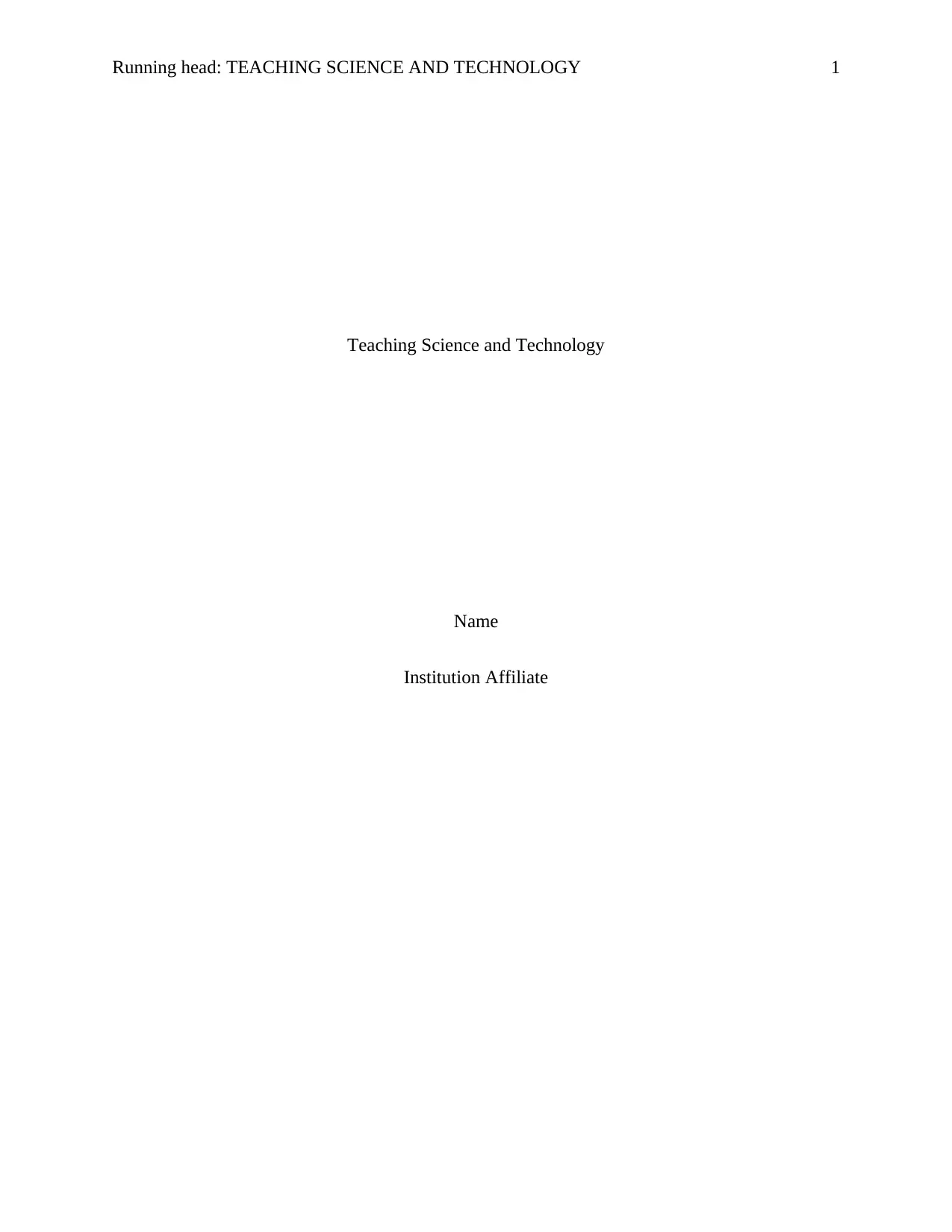
Running head: TEACHING SCIENCE AND TECHNOLOGY 1
Teaching Science and Technology
Name
Institution Affiliate
Teaching Science and Technology
Name
Institution Affiliate
Paraphrase This Document
Need a fresh take? Get an instant paraphrase of this document with our AI Paraphraser
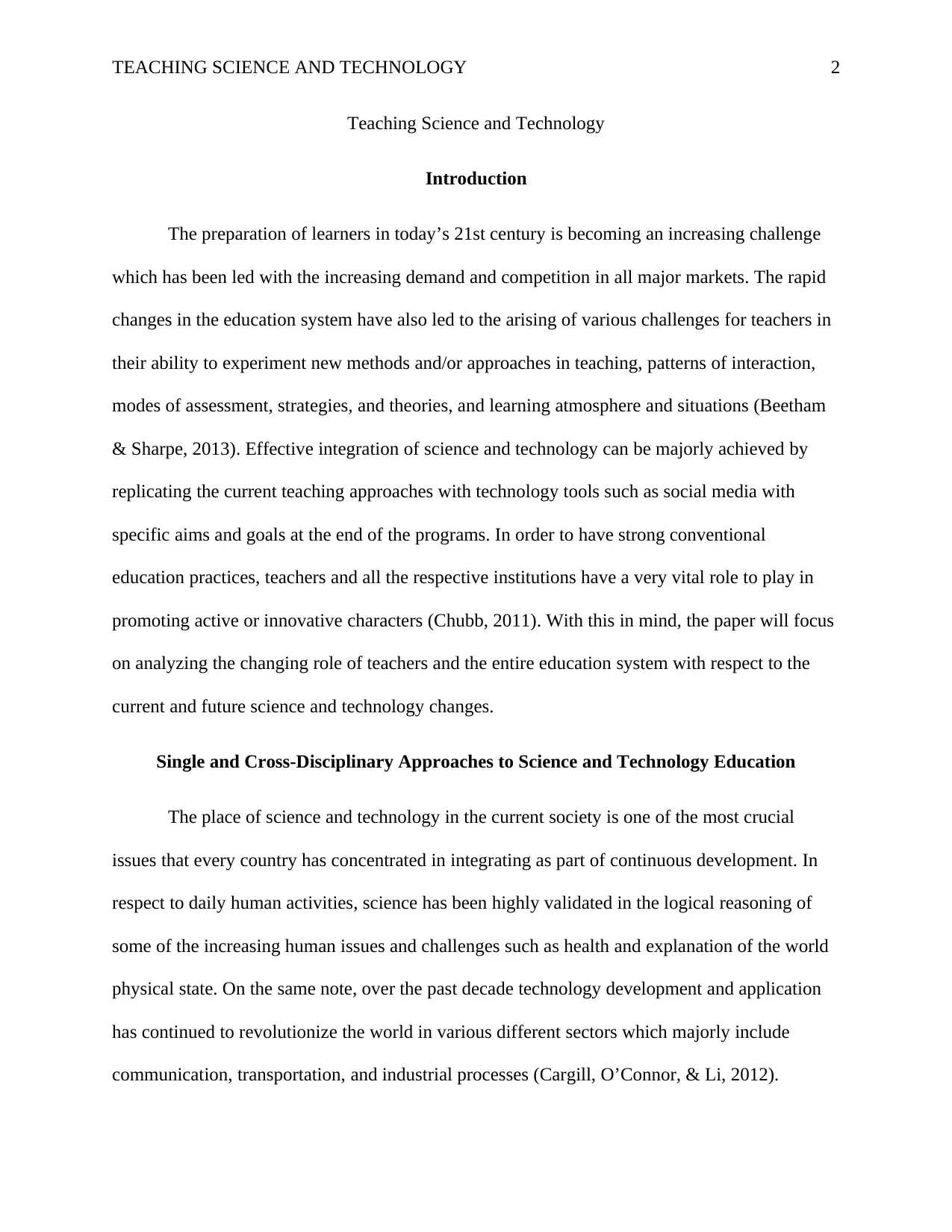
TEACHING SCIENCE AND TECHNOLOGY 2
Teaching Science and Technology
Introduction
The preparation of learners in today’s 21st century is becoming an increasing challenge
which has been led with the increasing demand and competition in all major markets. The rapid
changes in the education system have also led to the arising of various challenges for teachers in
their ability to experiment new methods and/or approaches in teaching, patterns of interaction,
modes of assessment, strategies, and theories, and learning atmosphere and situations (Beetham
& Sharpe, 2013). Effective integration of science and technology can be majorly achieved by
replicating the current teaching approaches with technology tools such as social media with
specific aims and goals at the end of the programs. In order to have strong conventional
education practices, teachers and all the respective institutions have a very vital role to play in
promoting active or innovative characters (Chubb, 2011). With this in mind, the paper will focus
on analyzing the changing role of teachers and the entire education system with respect to the
current and future science and technology changes.
Single and Cross-Disciplinary Approaches to Science and Technology Education
The place of science and technology in the current society is one of the most crucial
issues that every country has concentrated in integrating as part of continuous development. In
respect to daily human activities, science has been highly validated in the logical reasoning of
some of the increasing human issues and challenges such as health and explanation of the world
physical state. On the same note, over the past decade technology development and application
has continued to revolutionize the world in various different sectors which majorly include
communication, transportation, and industrial processes (Cargill, O’Connor, & Li, 2012).
Teaching Science and Technology
Introduction
The preparation of learners in today’s 21st century is becoming an increasing challenge
which has been led with the increasing demand and competition in all major markets. The rapid
changes in the education system have also led to the arising of various challenges for teachers in
their ability to experiment new methods and/or approaches in teaching, patterns of interaction,
modes of assessment, strategies, and theories, and learning atmosphere and situations (Beetham
& Sharpe, 2013). Effective integration of science and technology can be majorly achieved by
replicating the current teaching approaches with technology tools such as social media with
specific aims and goals at the end of the programs. In order to have strong conventional
education practices, teachers and all the respective institutions have a very vital role to play in
promoting active or innovative characters (Chubb, 2011). With this in mind, the paper will focus
on analyzing the changing role of teachers and the entire education system with respect to the
current and future science and technology changes.
Single and Cross-Disciplinary Approaches to Science and Technology Education
The place of science and technology in the current society is one of the most crucial
issues that every country has concentrated in integrating as part of continuous development. In
respect to daily human activities, science has been highly validated in the logical reasoning of
some of the increasing human issues and challenges such as health and explanation of the world
physical state. On the same note, over the past decade technology development and application
has continued to revolutionize the world in various different sectors which majorly include
communication, transportation, and industrial processes (Cargill, O’Connor, & Li, 2012).
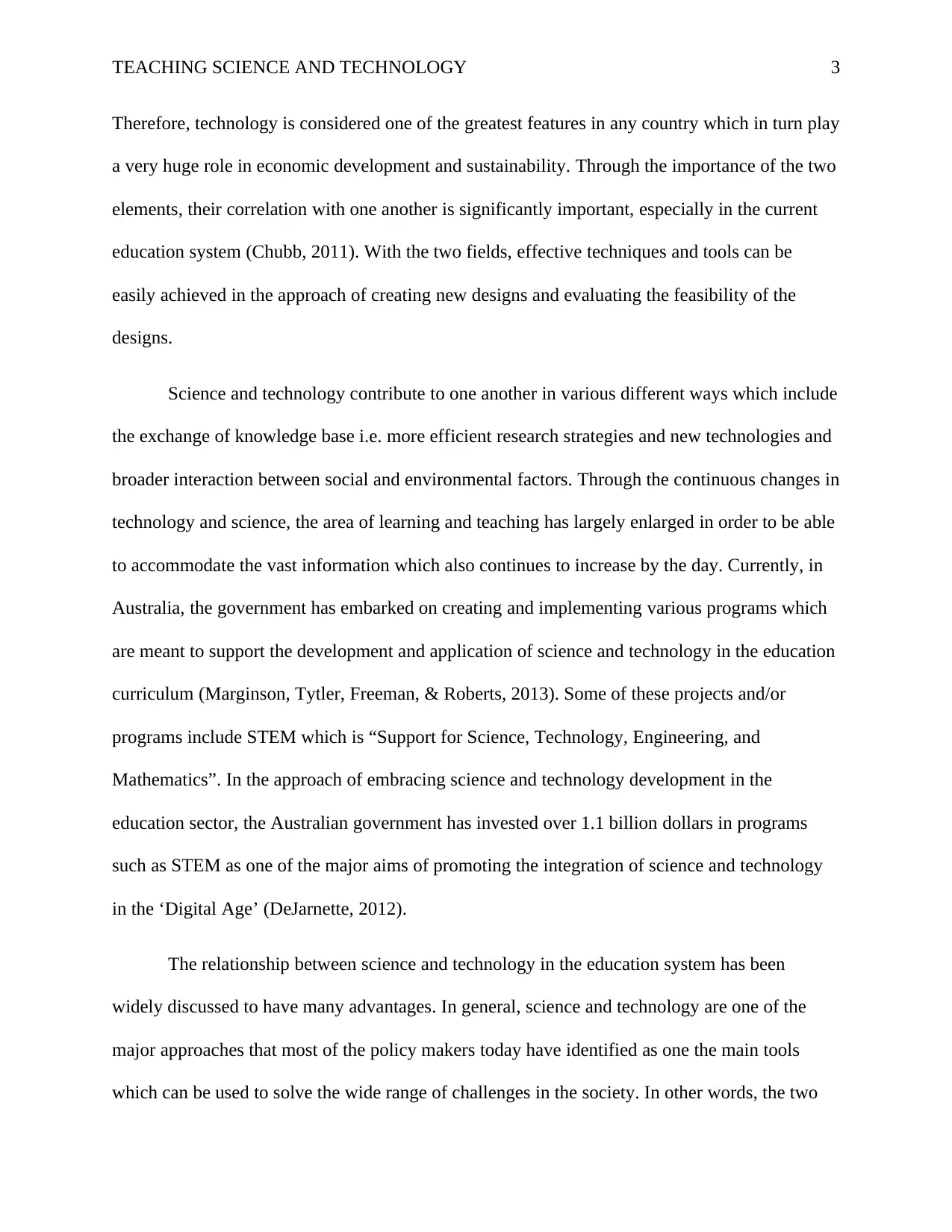
TEACHING SCIENCE AND TECHNOLOGY 3
Therefore, technology is considered one of the greatest features in any country which in turn play
a very huge role in economic development and sustainability. Through the importance of the two
elements, their correlation with one another is significantly important, especially in the current
education system (Chubb, 2011). With the two fields, effective techniques and tools can be
easily achieved in the approach of creating new designs and evaluating the feasibility of the
designs.
Science and technology contribute to one another in various different ways which include
the exchange of knowledge base i.e. more efficient research strategies and new technologies and
broader interaction between social and environmental factors. Through the continuous changes in
technology and science, the area of learning and teaching has largely enlarged in order to be able
to accommodate the vast information which also continues to increase by the day. Currently, in
Australia, the government has embarked on creating and implementing various programs which
are meant to support the development and application of science and technology in the education
curriculum (Marginson, Tytler, Freeman, & Roberts, 2013). Some of these projects and/or
programs include STEM which is “Support for Science, Technology, Engineering, and
Mathematics”. In the approach of embracing science and technology development in the
education sector, the Australian government has invested over 1.1 billion dollars in programs
such as STEM as one of the major aims of promoting the integration of science and technology
in the ‘Digital Age’ (DeJarnette, 2012).
The relationship between science and technology in the education system has been
widely discussed to have many advantages. In general, science and technology are one of the
major approaches that most of the policy makers today have identified as one the main tools
which can be used to solve the wide range of challenges in the society. In other words, the two
Therefore, technology is considered one of the greatest features in any country which in turn play
a very huge role in economic development and sustainability. Through the importance of the two
elements, their correlation with one another is significantly important, especially in the current
education system (Chubb, 2011). With the two fields, effective techniques and tools can be
easily achieved in the approach of creating new designs and evaluating the feasibility of the
designs.
Science and technology contribute to one another in various different ways which include
the exchange of knowledge base i.e. more efficient research strategies and new technologies and
broader interaction between social and environmental factors. Through the continuous changes in
technology and science, the area of learning and teaching has largely enlarged in order to be able
to accommodate the vast information which also continues to increase by the day. Currently, in
Australia, the government has embarked on creating and implementing various programs which
are meant to support the development and application of science and technology in the education
curriculum (Marginson, Tytler, Freeman, & Roberts, 2013). Some of these projects and/or
programs include STEM which is “Support for Science, Technology, Engineering, and
Mathematics”. In the approach of embracing science and technology development in the
education sector, the Australian government has invested over 1.1 billion dollars in programs
such as STEM as one of the major aims of promoting the integration of science and technology
in the ‘Digital Age’ (DeJarnette, 2012).
The relationship between science and technology in the education system has been
widely discussed to have many advantages. In general, science and technology are one of the
major approaches that most of the policy makers today have identified as one the main tools
which can be used to solve the wide range of challenges in the society. In other words, the two
⊘ This is a preview!⊘
Do you want full access?
Subscribe today to unlock all pages.

Trusted by 1+ million students worldwide
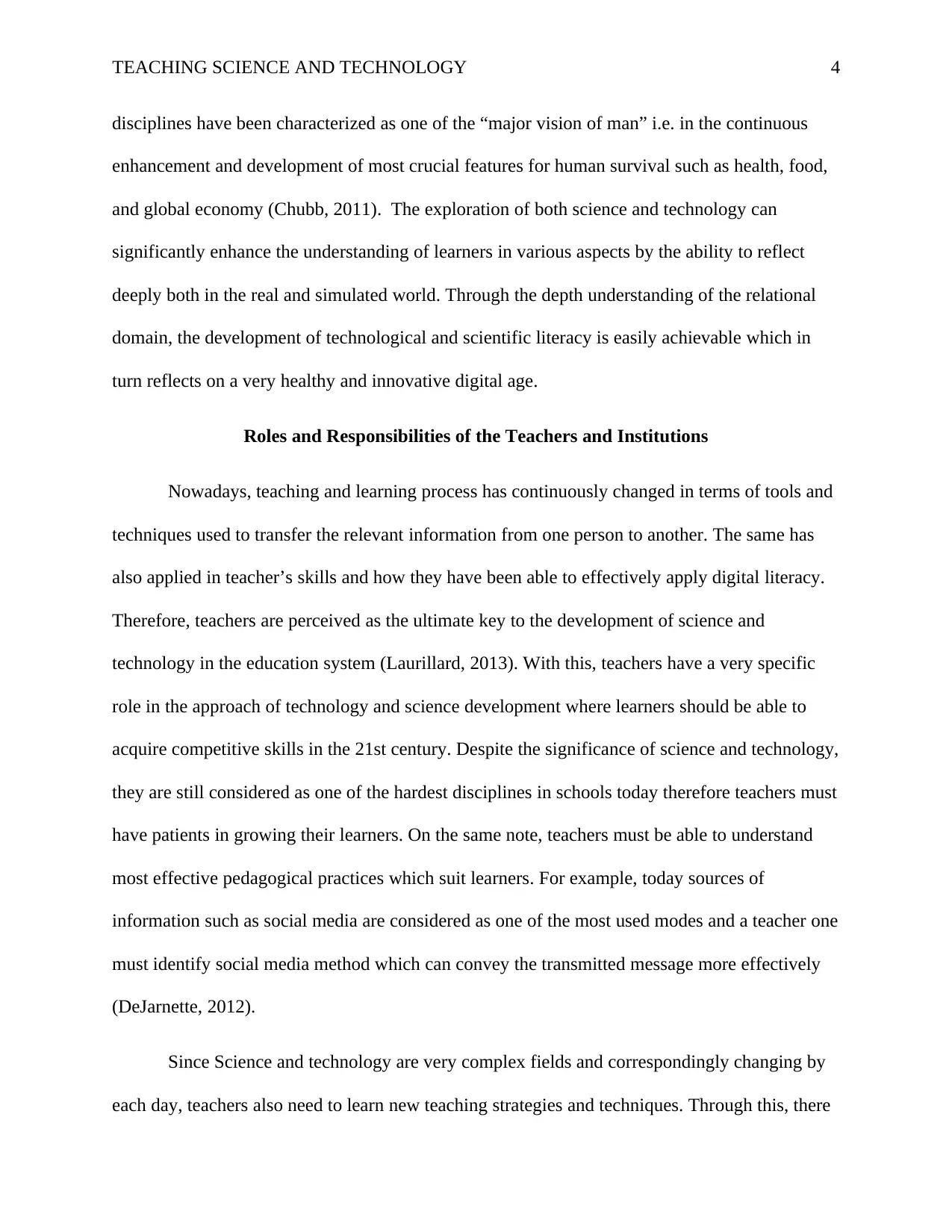
TEACHING SCIENCE AND TECHNOLOGY 4
disciplines have been characterized as one of the “major vision of man” i.e. in the continuous
enhancement and development of most crucial features for human survival such as health, food,
and global economy (Chubb, 2011). The exploration of both science and technology can
significantly enhance the understanding of learners in various aspects by the ability to reflect
deeply both in the real and simulated world. Through the depth understanding of the relational
domain, the development of technological and scientific literacy is easily achievable which in
turn reflects on a very healthy and innovative digital age.
Roles and Responsibilities of the Teachers and Institutions
Nowadays, teaching and learning process has continuously changed in terms of tools and
techniques used to transfer the relevant information from one person to another. The same has
also applied in teacher’s skills and how they have been able to effectively apply digital literacy.
Therefore, teachers are perceived as the ultimate key to the development of science and
technology in the education system (Laurillard, 2013). With this, teachers have a very specific
role in the approach of technology and science development where learners should be able to
acquire competitive skills in the 21st century. Despite the significance of science and technology,
they are still considered as one of the hardest disciplines in schools today therefore teachers must
have patients in growing their learners. On the same note, teachers must be able to understand
most effective pedagogical practices which suit learners. For example, today sources of
information such as social media are considered as one of the most used modes and a teacher one
must identify social media method which can convey the transmitted message more effectively
(DeJarnette, 2012).
Since Science and technology are very complex fields and correspondingly changing by
each day, teachers also need to learn new teaching strategies and techniques. Through this, there
disciplines have been characterized as one of the “major vision of man” i.e. in the continuous
enhancement and development of most crucial features for human survival such as health, food,
and global economy (Chubb, 2011). The exploration of both science and technology can
significantly enhance the understanding of learners in various aspects by the ability to reflect
deeply both in the real and simulated world. Through the depth understanding of the relational
domain, the development of technological and scientific literacy is easily achievable which in
turn reflects on a very healthy and innovative digital age.
Roles and Responsibilities of the Teachers and Institutions
Nowadays, teaching and learning process has continuously changed in terms of tools and
techniques used to transfer the relevant information from one person to another. The same has
also applied in teacher’s skills and how they have been able to effectively apply digital literacy.
Therefore, teachers are perceived as the ultimate key to the development of science and
technology in the education system (Laurillard, 2013). With this, teachers have a very specific
role in the approach of technology and science development where learners should be able to
acquire competitive skills in the 21st century. Despite the significance of science and technology,
they are still considered as one of the hardest disciplines in schools today therefore teachers must
have patients in growing their learners. On the same note, teachers must be able to understand
most effective pedagogical practices which suit learners. For example, today sources of
information such as social media are considered as one of the most used modes and a teacher one
must identify social media method which can convey the transmitted message more effectively
(DeJarnette, 2012).
Since Science and technology are very complex fields and correspondingly changing by
each day, teachers also need to learn new teaching strategies and techniques. Through this, there
Paraphrase This Document
Need a fresh take? Get an instant paraphrase of this document with our AI Paraphraser
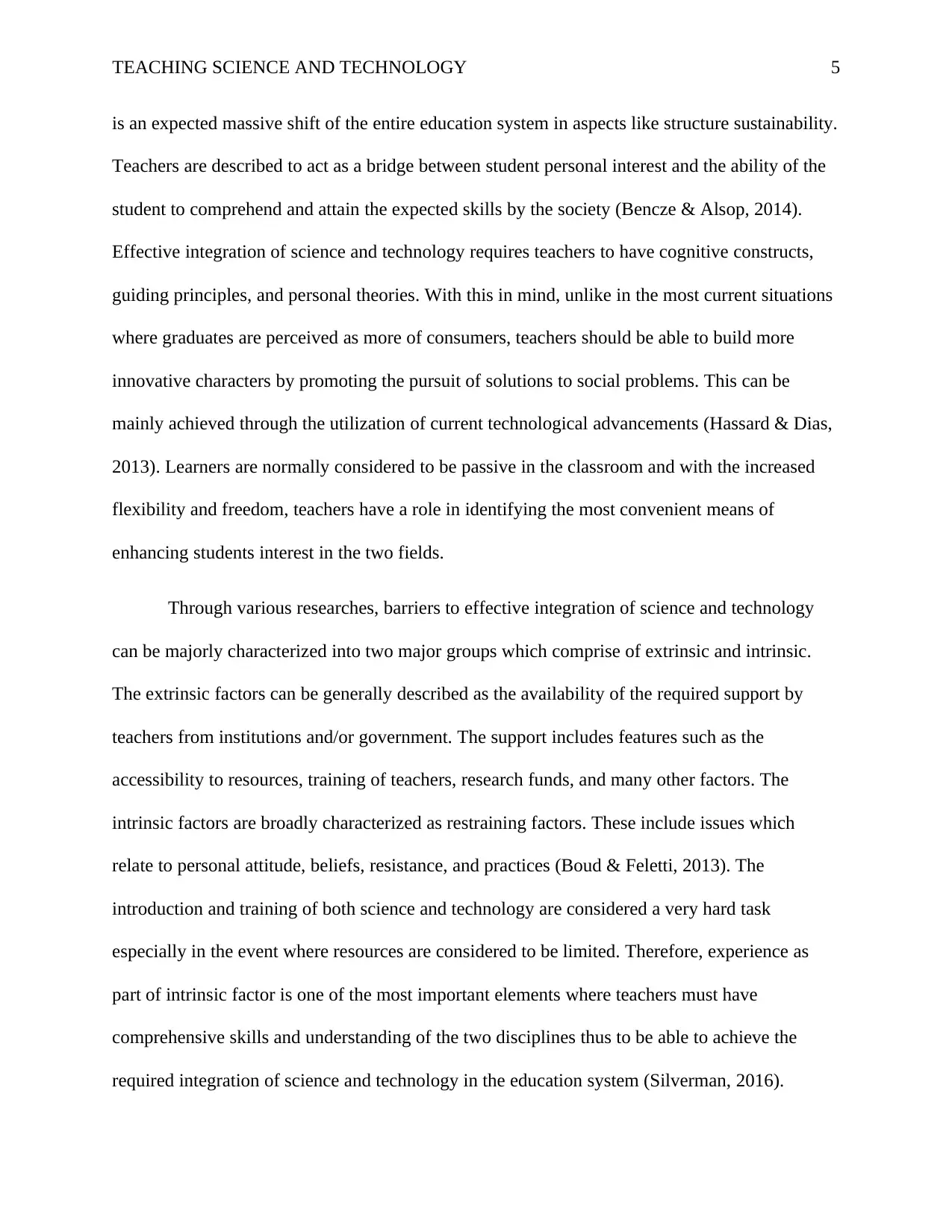
TEACHING SCIENCE AND TECHNOLOGY 5
is an expected massive shift of the entire education system in aspects like structure sustainability.
Teachers are described to act as a bridge between student personal interest and the ability of the
student to comprehend and attain the expected skills by the society (Bencze & Alsop, 2014).
Effective integration of science and technology requires teachers to have cognitive constructs,
guiding principles, and personal theories. With this in mind, unlike in the most current situations
where graduates are perceived as more of consumers, teachers should be able to build more
innovative characters by promoting the pursuit of solutions to social problems. This can be
mainly achieved through the utilization of current technological advancements (Hassard & Dias,
2013). Learners are normally considered to be passive in the classroom and with the increased
flexibility and freedom, teachers have a role in identifying the most convenient means of
enhancing students interest in the two fields.
Through various researches, barriers to effective integration of science and technology
can be majorly characterized into two major groups which comprise of extrinsic and intrinsic.
The extrinsic factors can be generally described as the availability of the required support by
teachers from institutions and/or government. The support includes features such as the
accessibility to resources, training of teachers, research funds, and many other factors. The
intrinsic factors are broadly characterized as restraining factors. These include issues which
relate to personal attitude, beliefs, resistance, and practices (Boud & Feletti, 2013). The
introduction and training of both science and technology are considered a very hard task
especially in the event where resources are considered to be limited. Therefore, experience as
part of intrinsic factor is one of the most important elements where teachers must have
comprehensive skills and understanding of the two disciplines thus to be able to achieve the
required integration of science and technology in the education system (Silverman, 2016).
is an expected massive shift of the entire education system in aspects like structure sustainability.
Teachers are described to act as a bridge between student personal interest and the ability of the
student to comprehend and attain the expected skills by the society (Bencze & Alsop, 2014).
Effective integration of science and technology requires teachers to have cognitive constructs,
guiding principles, and personal theories. With this in mind, unlike in the most current situations
where graduates are perceived as more of consumers, teachers should be able to build more
innovative characters by promoting the pursuit of solutions to social problems. This can be
mainly achieved through the utilization of current technological advancements (Hassard & Dias,
2013). Learners are normally considered to be passive in the classroom and with the increased
flexibility and freedom, teachers have a role in identifying the most convenient means of
enhancing students interest in the two fields.
Through various researches, barriers to effective integration of science and technology
can be majorly characterized into two major groups which comprise of extrinsic and intrinsic.
The extrinsic factors can be generally described as the availability of the required support by
teachers from institutions and/or government. The support includes features such as the
accessibility to resources, training of teachers, research funds, and many other factors. The
intrinsic factors are broadly characterized as restraining factors. These include issues which
relate to personal attitude, beliefs, resistance, and practices (Boud & Feletti, 2013). The
introduction and training of both science and technology are considered a very hard task
especially in the event where resources are considered to be limited. Therefore, experience as
part of intrinsic factor is one of the most important elements where teachers must have
comprehensive skills and understanding of the two disciplines thus to be able to achieve the
required integration of science and technology in the education system (Silverman, 2016).
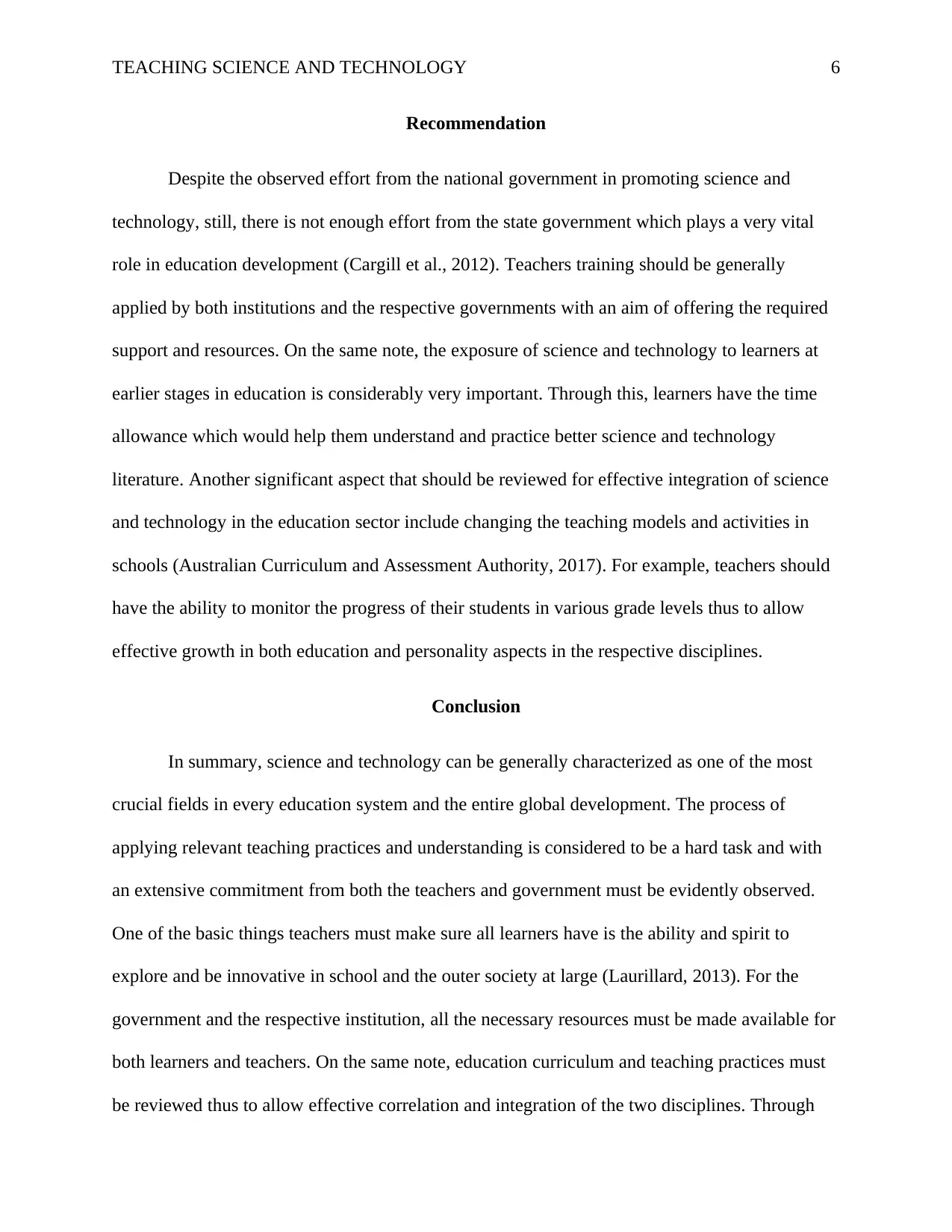
TEACHING SCIENCE AND TECHNOLOGY 6
Recommendation
Despite the observed effort from the national government in promoting science and
technology, still, there is not enough effort from the state government which plays a very vital
role in education development (Cargill et al., 2012). Teachers training should be generally
applied by both institutions and the respective governments with an aim of offering the required
support and resources. On the same note, the exposure of science and technology to learners at
earlier stages in education is considerably very important. Through this, learners have the time
allowance which would help them understand and practice better science and technology
literature. Another significant aspect that should be reviewed for effective integration of science
and technology in the education sector include changing the teaching models and activities in
schools (Australian Curriculum and Assessment Authority, 2017). For example, teachers should
have the ability to monitor the progress of their students in various grade levels thus to allow
effective growth in both education and personality aspects in the respective disciplines.
Conclusion
In summary, science and technology can be generally characterized as one of the most
crucial fields in every education system and the entire global development. The process of
applying relevant teaching practices and understanding is considered to be a hard task and with
an extensive commitment from both the teachers and government must be evidently observed.
One of the basic things teachers must make sure all learners have is the ability and spirit to
explore and be innovative in school and the outer society at large (Laurillard, 2013). For the
government and the respective institution, all the necessary resources must be made available for
both learners and teachers. On the same note, education curriculum and teaching practices must
be reviewed thus to allow effective correlation and integration of the two disciplines. Through
Recommendation
Despite the observed effort from the national government in promoting science and
technology, still, there is not enough effort from the state government which plays a very vital
role in education development (Cargill et al., 2012). Teachers training should be generally
applied by both institutions and the respective governments with an aim of offering the required
support and resources. On the same note, the exposure of science and technology to learners at
earlier stages in education is considerably very important. Through this, learners have the time
allowance which would help them understand and practice better science and technology
literature. Another significant aspect that should be reviewed for effective integration of science
and technology in the education sector include changing the teaching models and activities in
schools (Australian Curriculum and Assessment Authority, 2017). For example, teachers should
have the ability to monitor the progress of their students in various grade levels thus to allow
effective growth in both education and personality aspects in the respective disciplines.
Conclusion
In summary, science and technology can be generally characterized as one of the most
crucial fields in every education system and the entire global development. The process of
applying relevant teaching practices and understanding is considered to be a hard task and with
an extensive commitment from both the teachers and government must be evidently observed.
One of the basic things teachers must make sure all learners have is the ability and spirit to
explore and be innovative in school and the outer society at large (Laurillard, 2013). For the
government and the respective institution, all the necessary resources must be made available for
both learners and teachers. On the same note, education curriculum and teaching practices must
be reviewed thus to allow effective correlation and integration of the two disciplines. Through
⊘ This is a preview!⊘
Do you want full access?
Subscribe today to unlock all pages.

Trusted by 1+ million students worldwide
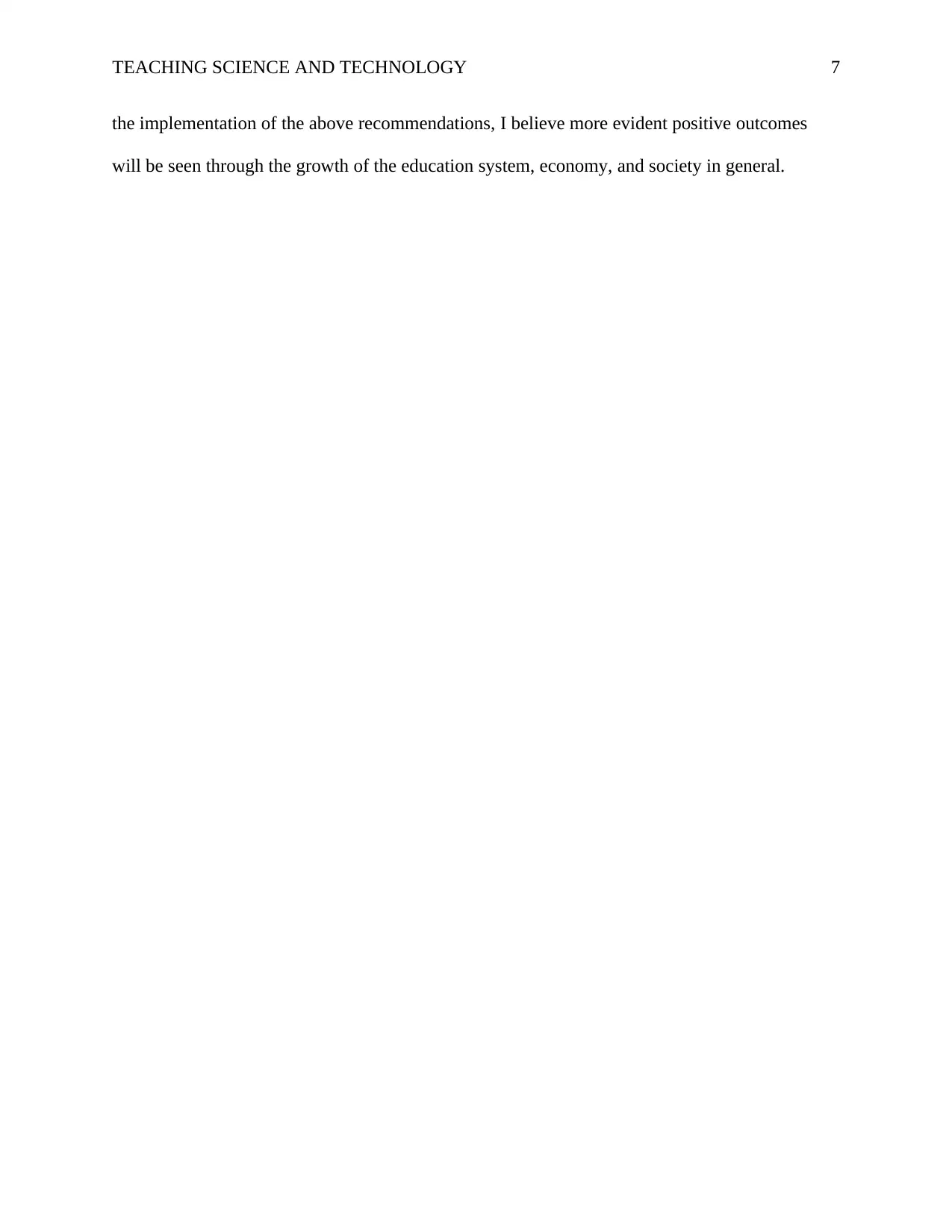
TEACHING SCIENCE AND TECHNOLOGY 7
the implementation of the above recommendations, I believe more evident positive outcomes
will be seen through the growth of the education system, economy, and society in general.
the implementation of the above recommendations, I believe more evident positive outcomes
will be seen through the growth of the education system, economy, and society in general.
Paraphrase This Document
Need a fresh take? Get an instant paraphrase of this document with our AI Paraphraser
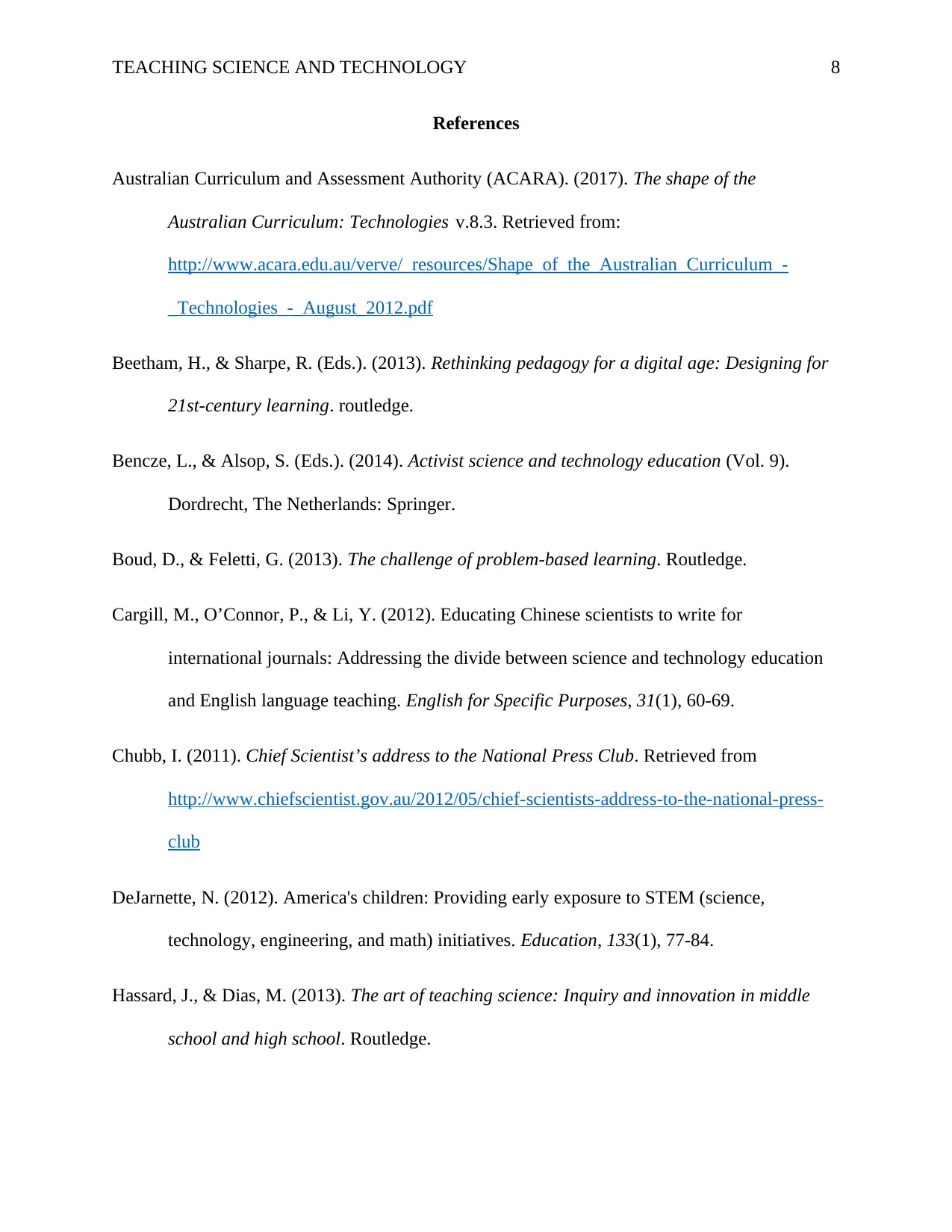
TEACHING SCIENCE AND TECHNOLOGY 8
References
Australian Curriculum and Assessment Authority (ACARA). (2017). The shape of the
Australian Curriculum: Technologies v.8.3. Retrieved from:
http://www.acara.edu.au/verve/_resources/Shape_of_the_Australian_Curriculum_-
_Technologies_-_August_2012.pdf
Beetham, H., & Sharpe, R. (Eds.). (2013). Rethinking pedagogy for a digital age: Designing for
21st-century learning. routledge.
Bencze, L., & Alsop, S. (Eds.). (2014). Activist science and technology education (Vol. 9).
Dordrecht, The Netherlands: Springer.
Boud, D., & Feletti, G. (2013). The challenge of problem-based learning. Routledge.
Cargill, M., O’Connor, P., & Li, Y. (2012). Educating Chinese scientists to write for
international journals: Addressing the divide between science and technology education
and English language teaching. English for Specific Purposes, 31(1), 60-69.
Chubb, I. (2011). Chief Scientist’s address to the National Press Club. Retrieved from
http://www.chiefscientist.gov.au/2012/05/chief-scientists-address-to-the-national-press-
club
DeJarnette, N. (2012). America's children: Providing early exposure to STEM (science,
technology, engineering, and math) initiatives. Education, 133(1), 77-84.
Hassard, J., & Dias, M. (2013). The art of teaching science: Inquiry and innovation in middle
school and high school. Routledge.
References
Australian Curriculum and Assessment Authority (ACARA). (2017). The shape of the
Australian Curriculum: Technologies v.8.3. Retrieved from:
http://www.acara.edu.au/verve/_resources/Shape_of_the_Australian_Curriculum_-
_Technologies_-_August_2012.pdf
Beetham, H., & Sharpe, R. (Eds.). (2013). Rethinking pedagogy for a digital age: Designing for
21st-century learning. routledge.
Bencze, L., & Alsop, S. (Eds.). (2014). Activist science and technology education (Vol. 9).
Dordrecht, The Netherlands: Springer.
Boud, D., & Feletti, G. (2013). The challenge of problem-based learning. Routledge.
Cargill, M., O’Connor, P., & Li, Y. (2012). Educating Chinese scientists to write for
international journals: Addressing the divide between science and technology education
and English language teaching. English for Specific Purposes, 31(1), 60-69.
Chubb, I. (2011). Chief Scientist’s address to the National Press Club. Retrieved from
http://www.chiefscientist.gov.au/2012/05/chief-scientists-address-to-the-national-press-
club
DeJarnette, N. (2012). America's children: Providing early exposure to STEM (science,
technology, engineering, and math) initiatives. Education, 133(1), 77-84.
Hassard, J., & Dias, M. (2013). The art of teaching science: Inquiry and innovation in middle
school and high school. Routledge.
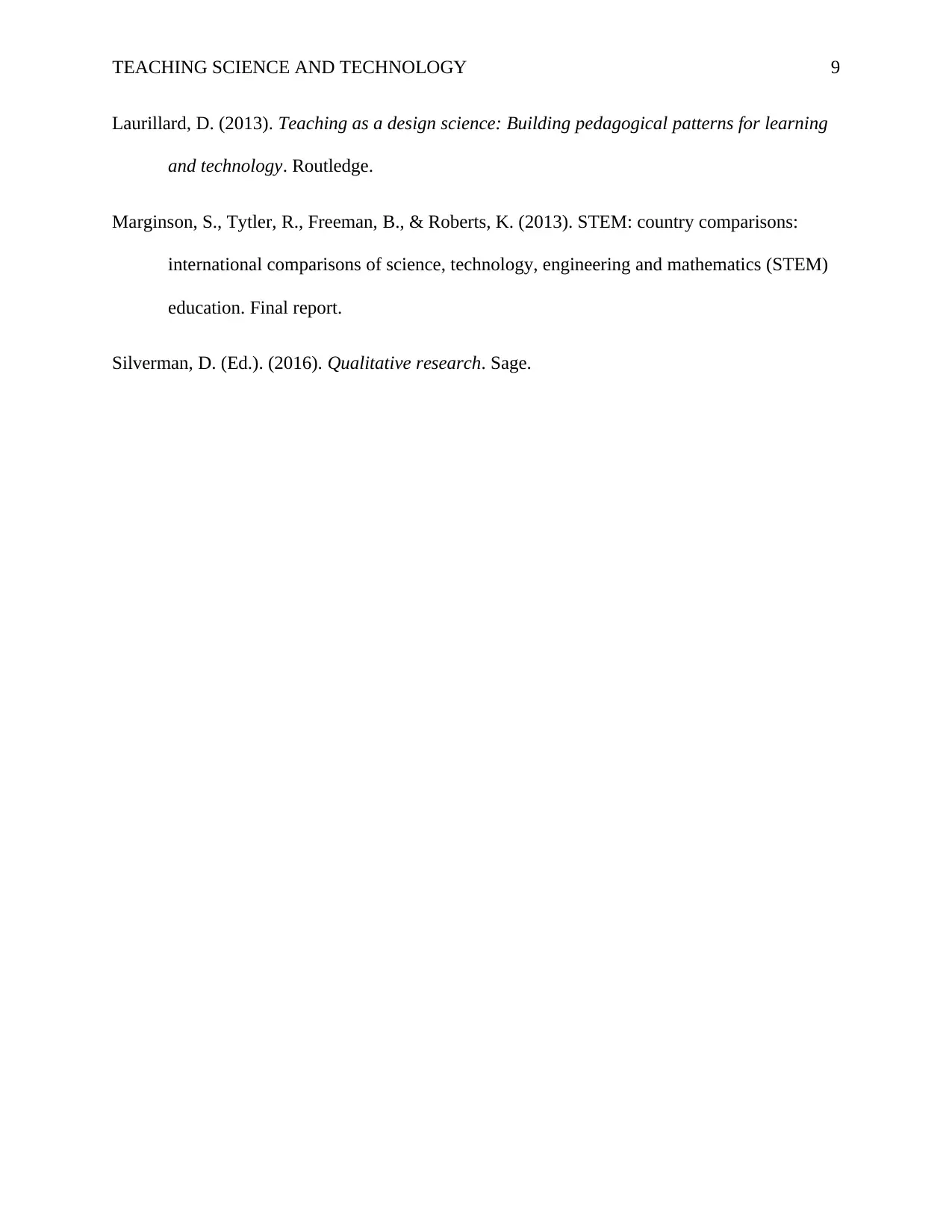
TEACHING SCIENCE AND TECHNOLOGY 9
Laurillard, D. (2013). Teaching as a design science: Building pedagogical patterns for learning
and technology. Routledge.
Marginson, S., Tytler, R., Freeman, B., & Roberts, K. (2013). STEM: country comparisons:
international comparisons of science, technology, engineering and mathematics (STEM)
education. Final report.
Silverman, D. (Ed.). (2016). Qualitative research. Sage.
Laurillard, D. (2013). Teaching as a design science: Building pedagogical patterns for learning
and technology. Routledge.
Marginson, S., Tytler, R., Freeman, B., & Roberts, K. (2013). STEM: country comparisons:
international comparisons of science, technology, engineering and mathematics (STEM)
education. Final report.
Silverman, D. (Ed.). (2016). Qualitative research. Sage.
⊘ This is a preview!⊘
Do you want full access?
Subscribe today to unlock all pages.

Trusted by 1+ million students worldwide
1 out of 9
Related Documents
Your All-in-One AI-Powered Toolkit for Academic Success.
+13062052269
info@desklib.com
Available 24*7 on WhatsApp / Email
![[object Object]](/_next/static/media/star-bottom.7253800d.svg)
Unlock your academic potential
Copyright © 2020–2025 A2Z Services. All Rights Reserved. Developed and managed by ZUCOL.





